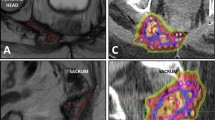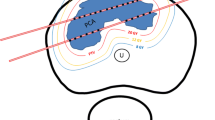Purpose:
To report the methods and clinical results of CT-based interstitial high-dose-rate (HDR) brachytherapy procedures for the palliative treatment of recurrent rectal cancer.
Patients and Methods: A total of 44 brachytherapy implants were performed in 38 patients. CT-guided catheter implants were performed in 34 patients under local anesthesia and sedation, and four patients were implanted intraoperatively. Of 40 CT-guided implants, 20 were done using metallic needles introduced via the sacrum and 20 were transperineal implants of plastic tubes in the presacral region. Postimplant CT scans were used for three-dimensional (3-D) conformal brachytherapy planning. Patients implanted with metallic needles were given a single fraction of 10–15 Gy using HDR 192Ir, and those who received transperineal implants of plastic catheters were given fractionated brachytherapy, 5 Gy twice daily to a total dose of 30–40 Gy. The median tumor volume was 225 cm3 with a range of 41–2,103 cm3.
Results: After a median follow-up of 23.4 months, a total of 13/38 patients were alive. The median postbrachytherapy survival was 15 months with 18 of the 25 deaths due to distant metastases. Tumor response was as follows: 6/38 partial remission, 28/38 stable disease, and 4/38 local progression. A planning target volume (PTV) coverage > 85% was achieved in 42/44 implants. The treatment was well tolerated, and no acute complications were observed. One patient developed a fistula after 8 months. Pain relief was recorded in 34 patients (89.5%), and the median duration of this palliative effect was 5 months with a range of 1–13 months.
Conclusions: Interstitial HDR brachytherapy is a valuable tool for the delivery of high doses and achieves effective palliation in recurrent rectal carcinoma.
Zielsetzung:
Beschreibung der Implantationstechniken und Ergebnisse der interstitiellen Brachytherapie in der Behandlung von Rektumkarzinomrezidiven.
Patienten und Methodik: Es wurden 44 interstitielle Behandlungen bei 38 Patienten mit einem Rektumkarzinomrezidiv durchgeführt. Bei vier Patienten wurden die Afterloading-Applikatoren intraoperativ platziert. 40 CT-gesteuerte Katheterimplantationen erfolgten bei 34 Patienten unter örtlicher Betäubung und Sedierung. Zwei CT-gesteuerte Techniken wurden angewandt: Von 40 Applikationen wurden 20 als Metallnadeln über das Sakrum (transsakrale Technik) und 20 als Kunststoffkatheter transperineal in die präsakrale Region eingeführt (transperineale Technik). Für die dreidimensionale Brachytherapieplanung schloss sich die Erstellung einer Computertomographie an. Patienten mit Metallnadelimplantaten wurde eine Einzeldosis von 10–15 Gy im High-Dose-Rate-(HDR-)Verfahren (192Ir) appliziert, während jene mit transperinealen Kunststoffimplantaten eine fraktionierte Brachytherapie erhielten (zweimal täglich 5 Gy bis zu einer Gesamtdosis von 30–40 Gy). Das mediane Tumorvolumen betrug 225 cm3 (41–2103 cm3).
Ergebnisse: Nach einer medianen Nachbeobachtungszeit von 23,4 Monaten waren 13 von 38 Patienten noch am Leben. Die mediane Überlebenszeit nach der Brachytherapie betrug 15 Monate. 18 der 25 Todesfälle waren Folge der Fernmetastasierung. 6/38 zeigten in der bildgebenden Verlaufsbeobachtung eine partielle Remission und 28/38 “stable disease”. Eine lokale Tumorprogression wurde bei 4/38 Patienten festgestellt. Eine Zielvolumenabdeckung > 85% konnte bei 42 von 44 Bestrahlungsplanungen erzielt werden. Die Behandlung wurde gut vertragen. Akute Komplikationen traten nicht auf. Ein Patient entwickelte 8 Monate nach erfolgter interstitieller HDR-Brachytherapie eine Fistel. Eine Schmerzreduktion gelang bei 34 Patienten (89,5%), die mediane Dauer dieses palliativen Effekts betrug 5 Monate (1–13 Monate).
Schlussfolgerungen: Die interstitielle HDR-Brachytherapie ist ein wertvolles Instrument zur Verabreichung hoher lokaler Strahlendosen und erzielt eine effektive Palliation bei Patienten mit nicht kurativ operablem Rektumkarzinomrezidiv.
Similar content being viewed by others
Author information
Authors and Affiliations
Additional information
Received: July 31, 2001; accepted: March 24, 2003
Address for Correspondence Priv.-Doz. Christos Kolotas, MD, Department of Radiation Oncology, Offenbach Hospital, Starkenburgring 66, 63069 Offenbach, Germany, Phone (+49/69) 8405-3335, Fax -3334, e-mail: ckolotas@aol.com
Rights and permissions
About this article
Cite this article
Kolotas, C., Röddiger, S., Strassmann, G. et al. Palliative Interstitial HDR Brachytherapy for Recurrent Rectal Cancer . Strahlenther Onkol 179, 458–463 (2003). https://doi.org/10.1007/s00066-003-0921-7
Issue Date:
DOI: https://doi.org/10.1007/s00066-003-0921-7




